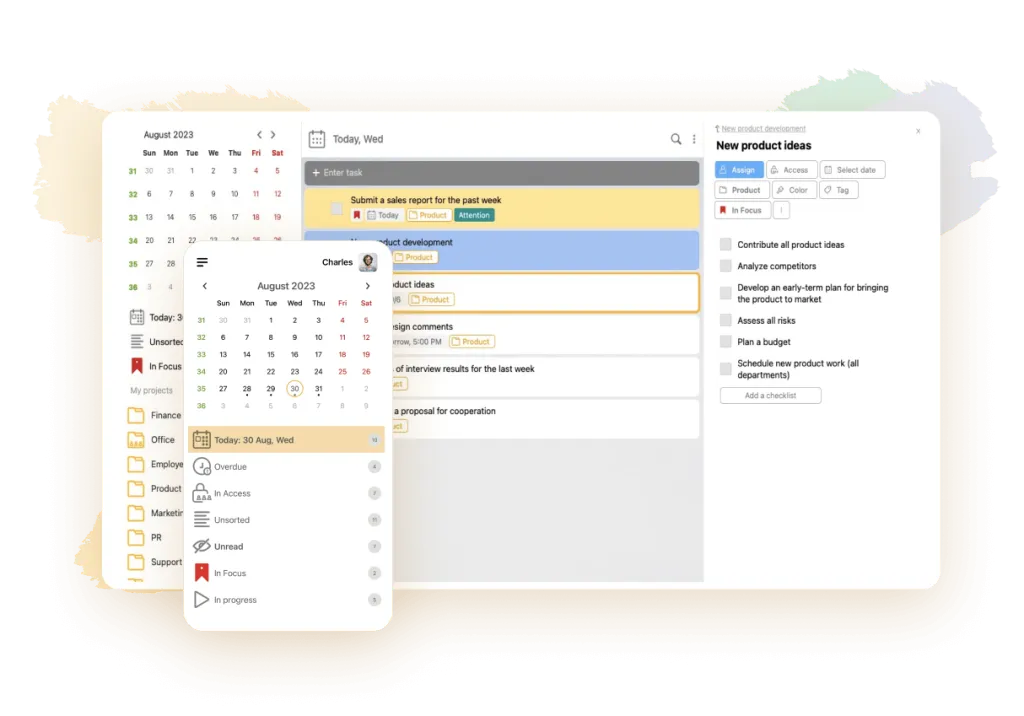
Ted Scott
February 12, 2024
One of the main factors affecting the profitability of any company is the productivity of its staff. If a business or organization’s monthly revenue has worked “in the plus” and suffered a significant loss in another month, there are specific, measurable reasons for this. One of them can be considered - ineffective performance of managers and salespeople. In large companies, it is physically difficult to track the quality of labor of each employee. Who is just sitting around, and who is working “for two”? Who should be paid a bonus or bonus, and who should be fired because of incompetence? To answer these questions, a special KPI metric is used, which numerically reflects the result and quality of actions for a certain period of time. Why is it needed and what does it mean? How is it applied in practice? Let’s try to understand and tell you about the economic importance of this coefficient.
What is KPI in simple words

The abbreviation KPI stands for Key Performance Indicator. This value demonstrates the effectiveness in achieving the set tasks and goals. It is used to track a variety of goals and objectives:
-
High level of focus, focusing on overall business performance.
-
Low-level metrics that assess the performance of individual processes and departments of the enterprise, such as marketing, sales, technical support or others. In this case, the metrics are improvised markers of productivity and performance of employees. Such a characteristic is calculated for all managers, employees, departments of the company. For example, the kipiay of a call center operator is determined by calculating the average time of call processing or the number of repeated calls from newly returned customers. Marketers are evaluated by the statistics of leads attracted over a certain period of time, sales managers - by the amount of deals they managed to complete with a positive result.
Key Performance Indicator index is effective in various business areas - from construction and decoration of apartments to management, promotion of the released product or sales. Sometimes this principle is used to evaluate the fulfillment of a plan according to a certain planning criterion. This scheme is also called “management by objectives”.
Why KPI measurement is necessary
Using this indicator of productivity and efficiency, it is possible to measure and calculate how much financially justified the efforts spent on the creation, release, promotion and advancement of the product, and what the result is in the end. The method is necessary to fulfill the following tasks:
-
To make a transparent, honest assessment of the performance of an entire company and each of its employees. Based on the achievement of established indicators, bonus payments are measured and calculated, salaries are calculated, and decisions are made on transferring or dismissing personnel.
-
Describing and organizing business processes taking place within the company. The use of a specific system helps to clearly see who and how performs the assigned tasks, what actions each team member is responsible for.
-
Strategic analysis and planning, taking into account the company’s weaknesses and growth points. This option allows to calculate and make timely adjustments to the strategy, set new goals and objectives, and reallocate available resources.
-
Motivating staff to achieve results promptly and quickly. Transparent conditions and evaluation criteria will help employees to concentrate on important and serious work to achieve success, without being distracted by empty, secondary and meaningless activities.
KPIs are taken into account only if they have a direct impact on business processes or the functioning of the company as a whole. Brief examples: failure to fulfill the quarterly sales plan or a decrease in the value of orders entails a decrease in the company’s profit. A small number of likes in VK or other social networks, the number of content views does not belong to these categories, except in situations where these indicators are key for the company. But, as a rule, this is very rare.
Advantages and disadvantages of the system
Personal observations and control by a manager are not always enough to justify a fair and objective assessment of personnel. Using key performance indicators, it is possible to get the most complete picture of the activity of each employee and the division as a whole. The system allows:
-
Combine the company’s overall development strategy with the results of its personnel.
-
Improve the overall qualification and professional skills of employees by eliminating “weak links”.
-
Communicate to performers the inevitability of responsibility for their actions.
-
Improve key performance indicators through partnerships and effective collaboration among all labor team members.
The use of KPI methodology helps to develop the most transparent and honest system of personnel incentives, where the amount of material remuneration or lack thereof is directly related to the quality of the performer’s work. The availability of verified, confirmed, recorded data or a report on the work performed will prevent the possibility of unjustified nagging from superiors.
There are also minuses to this business technology:
-
It takes a lot of time and resources to implement it.
-
It can prove to be a kind of demotivator in teamwork, as each employee will be interested in improving and achieving their own results.
-
Employees may focus solely on material benefits, which can negatively affect the quality of their work.
-
Some types of work cannot be deciphered and quantified. This applies to many creative professions. Therefore, it is impossible to apply a KPI system to them.
In general, it can be noted that this method of assessment is more suitable for a stable established business with a formalized structure. It is difficult to use it in start-ups, as they are only going through the initial stages of forming business processes. Besides, in small companies, employees usually have no problems with motivation. They actively communicate with each other, understand where they are aiming and what they want to achieve.Differences between KPIs and OKRs
As an alternative to key performance indicators, the concept of OKR (Objectives and Key Results) is sometimes used to motivate employees, which is a comprehensive goal-setting system consisting of two main elements:
-
Global objectives. For example: to make your app the most popular in PlayMarket.
-
The points that must be passed through to get the planned result. In this case, these may be the following points: 1) Clarify interests in the services of potential users; 2) Update the interface based on the instruction, trial tests and so on.
In essence, these two tools are very similar to each other. The difference between them lies in the nature of the tasks to be performed:
| KPI | OKR |
|---|---|
| Suitable for stable companies with structured, stable processes. This method of assessment is somewhat similar to a to do sheet. Each team member sees his tasks, knows what to do to accomplish them, and simply works in a regular mode. | It implies greater freedom of action. For example, when launching a new product and promoting it on the market. Because of the vague wording, it is more difficult to set KPIs here. But it is quite possible to define the checkpoints that need to be passed in the course of working on a task. |
The OKR technique is not suitable for all teams. There is often misunderstanding and resistance when trying to implement this metric to evaluate the performance of rank-and-file personnel. Not everyone is ready to set ambitious goals. For others, the feeling of freedom of action drives them into a real stupor. Therefore, when choosing a motivation system, it is absolutely necessary to calculate what is better in this case: KPI or OKR.
Types of KPIs

Initially, this methodology was used exclusively in the trade sector, where it was not necessary to perform complex calculations in order to clarify the performance of each department or employee. Key Performance Indicator was determined by the number and total amount of sales. Currently, the system is implemented almost everywhere. In different areas of business, their own metrics are used. Conditionally, the classification of key performance indicators is divided into two large groups:
-
Forward-looking, aimed at designing future processes. When setting them, they are oriented on forecasts. Examples from sales: conversion at different stages, number of calls.
-
Resulting or lagging, which are general plans for attracting customers, profit, turnover. They are set based on the analysis of past results.
KPIs are divided into internal and external KPIs according to their scale and sphere of influence. The first ones are used to assess the company’s internal achievements. This category includes product quality criteria, staff turnover, the size and list of advertising costs, and other criteria directly related to productivity growth. With their help, the business can forecast results and set new goals.
External indicators are a summarized expression of the results of the activities of the business units responsible for achieving the company’s overall goals. For example, expanding its target audience or entering the international market.
There is also a division of KPIs into absolute and relative metrics. Relative metrics interact with each other and other metrics, and are expressed in percentages or fractions.
Absolute indicators exist in isolation and are not compared to anything. Example: the amount of net profit for the sale of office supplies in thousand rubles or the company’s net profit for September. They have a numerical expression.
Application of KPIs in different business areas
Different industries have their own specific metrics that determine a company’s performance and efficiency.
Internet marketing
The indicators valid in this area are not related to personnel activities. To calculate them, data obtained from end-to-end analytics is used. Usually Google Analytics are used for this purpose. The indicators include:
-
ROI, which reflects the return on investment. It shows how much the company’s investment in advertising has paid off. This metric is one of the most important indicators analyzed by Internet marketers. If the ROI is more than 100%, it indicates that the advertising costs have been fully recouped by attracting new customers.
-
ROMI, return on marketing costs. It is determined by the formula: (Profit - Marketing Expenses) / Marketing Expenses × 100%.
-
CTR is calculated as the percentage of clicks on an ad. This parameter is used to evaluate creatives.
-
The number of leads is determined by the number of times a company is contacted after running an advertisement or promotion.
-
The cost per lead is the quotient of marketing costs (net advertising budget) to the number of leads. It means how much it cost the company to make calls or requests on the website.
Sales
This is where the quantity and quality of work performed is assessed. The following indicators are considered:
-
Average transaction period (the time it takes for a customer to move from interest directly to purchase).
-
AOV (Average Order Value) or the size of the average check per order. It is determined by the formula: total revenue/number of orders.
-
Number of successfully completed transactions, communications.
-
Sales conversion (the percentage of the number of transactions to the number of customers or clients).
-
Sales dynamics (growth rate compared to the previous period).
-
Number of newly referred customers.
Rules of implementation and calculation

When implementing a KPI system, it is important to take into account the current situation of the company. It is not necessary to restructure the entire operation of the company. It is better to start with a separate division, for example, sales or sales. The process of introducing new evaluation metrics is greatly simplified by the presence of a CRM-system, which is used by all managers. In most cases, these software products already contain indicators that can be used to determine the efficiency of any business.
To set KPIs correctly, managers should answer the questions:
-
What kind of result do you plan to get?
-
Why is he important to the company?
-
In what ways can it be influenced?
-
When can they be considered achieved? How will progress be monitored?
To get the best result when implementing the system, it is important to follow the following rules:
-
Communicate the personal benefits of the new appraisal format to your department heads and key influencers. Emphasize the importance and necessity of their cooperation. This process should not be perceived as something alien, imposed from above.
-
Switch to the new system in stages.
-
Start with the really important, core performance indicators. Their number should not exceed 5 metrics for each division or specialist. Otherwise, it will be impossible to focus on the necessary primary tasks.
-
Employees must have the ability to influence the set metrics, otherwise they will be meaningless.
-
KPI metrics should be aligned with the company’s overall strategy.
-
They must be logical and consistent. Otherwise, the introduction of a new system can lead to the exact opposite result: instead of growth, you will get a decrease in efficiency. Example: when we set a task for production to increase output by 30%, we do not coordinate it with the sales department. As a result, the surplus production just sits in the warehouse.
-
The introduction of KPI indicators should become an additional incentive for all employees, regardless of their function and position.
-
To successfully execute plans, always incorporate lessons learned from past projects and set specific, achievable goals for yourself and staff.
How KPI are calculated
For the calculation, you can create a KPI matrix in Excel, Google tables or other convenient program, taking into account the following data:
-
Key indicators. They should reflect the efficiency of the company, department, employee.
-
Bases, minimal results.
-
Norms, a binding result that must be, achieved under all circumstances.
-
Fact, the actual performance of an employee or department.
After filling in the appropriate boxes, calculations are performed using the formula:
KPI = ((Fact-Base)/(Norm-Base)) × 100%
Example:
Management has implemented key performance indicators in the sales department with a minimum number of deals: 200, and a target of 250. The manager successfully closed 270 during the reporting period. His KPI calculation would look as follows:
((270 - 200)/(250 - 200)) × 100% = 140%.
Mistakes in the implementation of the methodology
Despite the transparency and accuracy of this assessment tool, some managers have problems implementing KPI systems in sales, internet marketing, manufacturing or other areas of business. Usually associated with making the following mistakes:
-
Reducing employee salaries. Even if the bonus percentage of sales is increased, it should remain at the same level. Otherwise it will demotivate the staff.
-
Setting unattainable targets. Realizing that the set goals are impossible to achieve, no employee will make efforts to realize them.
-
Using random indicators that are not related to the company’s activities.
-
Entrusting the calculation of KPIs to unqualified performers. Mistakes made when calculating points or bonuses can cause serious discord in the team.
-
Unjustified complication of calculations, application of voluminous formulas not understood by the performer.
Application of LeaderTask service for tracking personnel efficiency

Regular monitoring of personnel and assessment of their performance brings great practical benefit to the company and its employees. Contractors clearly know what benefits they will receive if they successfully complete their assigned tasks. The business gets a professional, motivated team.
The LeaderTask electronic assistant is a convenient tool for planning and managing the company. In the application you can set tasks for your subordinates and colleagues, control the quality and deadlines of their fulfillment. Store important information about clients. Evaluate the performance and efficiency of the personnel working on the project.
A couple of clicks are enough to set a task, determine its deadline, and assign responsibility for its implementation. For clarity, large tasks can be broken down into smaller subtasks. This will help you keep all the important information and not lose sight of anything.
You can evaluate the performance of each performer on a graph or use detailed statistical information related to the project for analysis.
The application functions on all digital platforms, there is synchronization between all devices. It does not require an internet connection.
Conclusion
Every manager has the right to decide whether it is necessary to implement key performance indicators in their company. This process does require time, financial and other costs. But, if it is successfully completed, you will receive significant benefits for the development and growth of your business. You will be able to show additional attention to conscientious employees and get rid of lazy and procrastinators who are ballast for the company.








